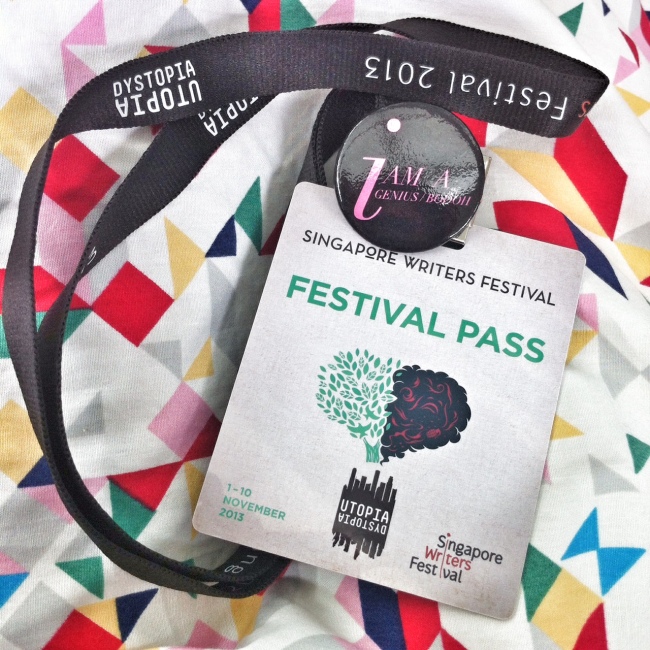Last weekend, my days started super early (I usually sleep in). I hate weekends if I have no plans. But that week, I was excited. My first literary festival! Yeayyy! I aspire to be a writer since I was young, for now, an educator first. Anyways, I never had any chance to attend literary fest or conference. Maybe because I am in the wrong circle as I never really gotten good inside news about literary conference going on. I wished I had gone for all the panel discussions and meet the authors sessions but I had to choose. So I chose my favourite writers; Khadijah Hashim and Dewi Lestari.
1. PANEL DISCUSSION: Atas Nama Cinta (In the name of love)
This discussion, moderated by Emelda Juhari featured two top writers, Khadijah Hashim and Isa Kamari to discuss the images of women in literature. So we discussed the portrayals of women in their writings. From how authors like to portray women were bad; prostitutes, evil step mother, cheating girlfriend etc, to how women are shown to rise from their fall and how women face challenges. Well, women in their portrayals, play important roles in society. I felt the one hour discussion was short with KH sidetracked almost all the time. I mean, I love her loads, but seriously, I came to hear why writers write such way about women. But I did enjoy the discussion. I saw in their perspectives, both KH & IK, the different ways women are being portrayed in novels.
According to KH, “…untuk mengangkat sesuatu masyarakat itu, wanita perlu diberi pelajaran..” which means that women have to be educated as well in order for society to prosper. Images of women in prose differs in a female author’s perspective from male author’s. Well, in IK’s point of view, readers must think when they read. Therefore, criticisms come about as different points of views.
I can quite agree that I love both perspectives, from a female writer and its male counterpart. Nevertheless, I got to have my Badai Semalam old school novel autographed by KH. So, I was happy.
2. PANEL DISCUSSION: Sastera Popular lawan Sastera Mapan (Popular vs Literary)
Comparative literature. Just what I love. Moderated by my ex lecturer, Dr Nazry Bahrawi, featuring KH, Cg Mohamed Latiff Mohamed, Rohman Munasip & Dewi Lestari. 
So, I have a lot to say! I truly enjoyed this session the most, not because Dewi Lestari was amongst the panelist, but really, there was so much enrichment. Cg Latiff was definitely against all the popular novels. According to him, artistic value, aesthetics and philosophy of a literary novel will not be jeopardized by time. Compared to popular novels which was rated by how many hundreds or thousands being sold, literary novels are hard to sell. I saw his point, when he mentioned “gangsterism and sex” being these popular novels main focus. I couldn’t agree more. Almost all popular novels that I have read, back when I was in secondary school and recently some now, have the same kinds of conflicts; teenage love, unrequited love, triangle love, drugs and sex. But I beg to differ, only very few popular novels portrayed heavy plots and conflicts. At a point there was a nice bicker as to how love is portrayed in popular novels compared to literary ones. However, RM said to label a novel is popular or literary is very subjective and it is readers’ rights.Nope, I am not going to mention how KH bragged about her 45 year old novel and still going strong.
All in all, to a certain extent when I felt this discussion, if prolonged, could have become a heated debate which I like. Having Dee in the panel gave us a different point of view from her perspective as she’s Indonesian and young. Seeing how their state of literary arts as compared to ours (Singapore & Malaysia), I think Dee also has a point when said it’s tough to make your novel break through as popular. A literary novel that withstand time, at some point, was a popular novel, yes? According to Dee, a novel has to get recognition from the media, be bestselling novel which means impact from readers, get recognition in festivals and the impact of the novel like how it can shape society. I don’t disagree. In fact, translated novels could fish the interest of foreign readers to inquire about the author.
3. Malay Literary Conferance: Sastera KOTA Sastera
This was the peak for me and probably for Malay literary arts in Singapore. Attended it alone and I truly felt tiny in a room filled with prolific writers and well-known authors and scholars. I kept to myself, intently listening to the papers presented, one by my ex-lecturer, Dr Nazry Bahrawi on images of ‘place’ in literature. He compared Suratman Markasan’s Penghulu and Andrea Hirata’s Laskar Pelangi (or The Rainbow Troops). It was enriching for me, maybe because I love comparative literature. And the fact that one statement, “Authors tend to feel god-like because they create the story.” (somewhere along the line) has actually sparked debate a short while. I was amused, but enlightened by this short debate nonetheless. A presentation from Noridah Kamari sparked my historical knowledge as she went through post-war periods which affected our literary arts. It was very enlightening for me.
Unfortunately for me, my attention span was short fused that day. The three hour conference turned out to be longer than expected. I wouldn’t mind a half day conference, even! If it had started out slightly earlier. Well, I vaguely remembered Putu Oka Sukanta’s words, “yang membingungkan itu lebih jernih...” (What confuses you is clearer.) I felt that the first part, when three papers presented was much more alive than the subsequent panel discussions.
I thoroughly enjoyed my first literary arts festival. And I hope it will not be my last. Who knows, one day, I might join those big shot writers and scholars…
